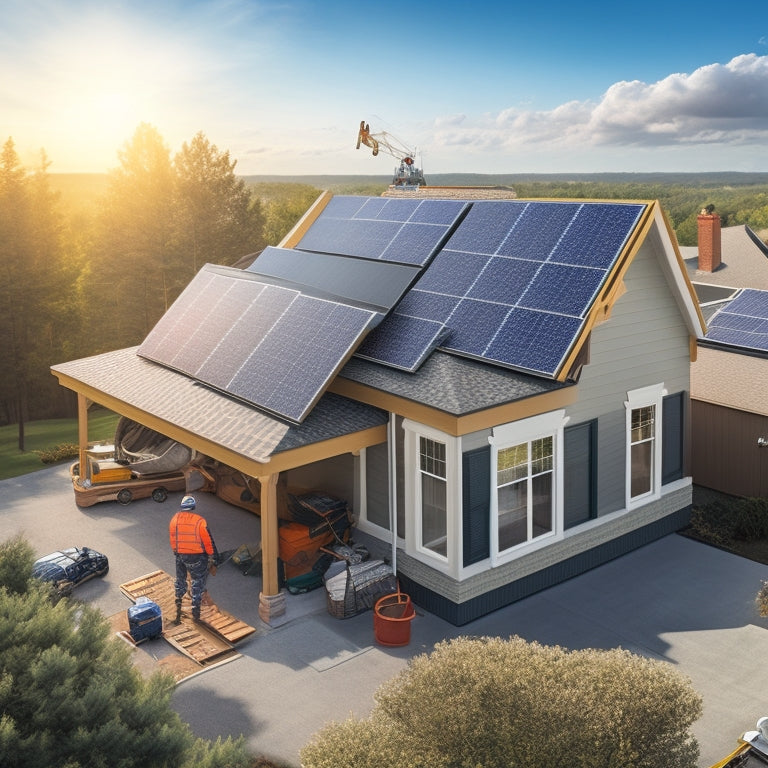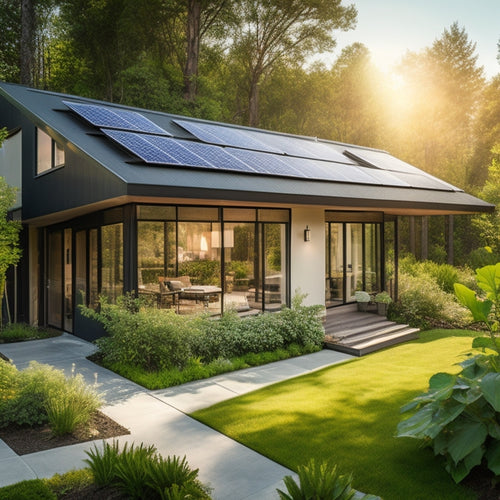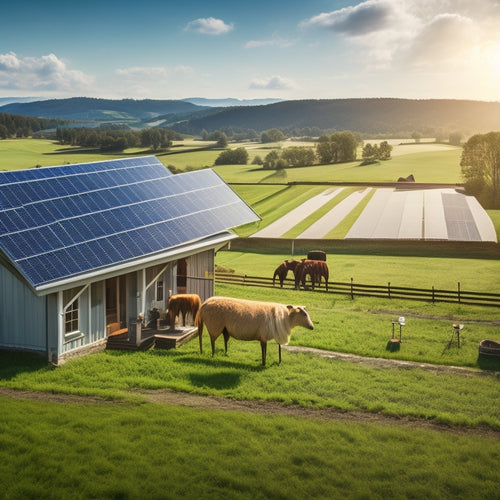
Installing Solar Panels With a New Roof in 7 Steps
Share
When installing solar panels with a new roof in 7 steps, you'll first assess your roof's condition, identifying damaged or loose shingles, wear around chimneys, and signs of animal infestation. Then, choose the right solar panels, considering efficiency ratings and budget constraints. Next, prepare for roof installation, researching local regulations and developing a maintenance plan. Install roofing materials, guaranteeing durability and weather-tightness, before securely mounting solar panels using techniques compatible with your roof type. Connect the panels to the electrical system, and finally, inspect and test the installation to verify compliance with local codes and manufacturer's specifications, and now you're ready to optimize your solar panel performance.
Key Takeaways
- Assess the roof's condition before installing solar panels to identify and address any underlying issues that may affect the installation.
- Choose the right solar panels based on energy needs, budget, and efficiency ratings to ensure optimal performance and energy production.
- Ensure a thorough roof inspection is conducted to identify potential obstacles and develop a plan to address them before installing solar panels.
- Select roofing materials that provide a secure base for solar panels, facilitate easy access and maintenance, and meet local weather conditions and building codes.
- Verify that the solar panel installation meets local building codes, manufacturer's specifications, and necessary permits and certifications before finalizing the installation.
Assess Your Roof's Condition
Get a handle on your roof's current state before installing solar panels. You'll want to identify any necessary repairs or replacements to guarantee a solid foundation for your new solar system.
Start by inspecting your roof's surface, looking for damaged, missing, or loose shingles, curled or buckled shingles, and signs of wear around chimneys, vents, and skylights. Check for sagging or uneven rooflines, which can indicate structural issues.
Next, examine your roof's underlying structure, including the condition of the rafters, trusses, and flashing. Make certain all components are securely fastened and show no signs of rot or water damage.
Weather impacts, such as high winds, hail, or heavy snowfall, can greatly affect your roof's integrity, so take these factors into account.
Proper roof maintenance is vital before installing solar panels. You don't want to invest in a new solar system only to have it compromised by a faulty roof.
Take the time to address any issues you find, and consider consulting a professional if you're unsure about any aspect of the process. A solid roof is essential for a successful solar panel installation.
Choose the Right Solar Panels
You'll need to select solar panels that meet your energy needs and fit your budget.
Consider panel efficiency ratings, as higher ratings can generate more power per hour of sunlight.
With budget-friendly options available, you can balance efficiency with cost to find the right panels for your new roof.
Panel Efficiency Ratings
When sizing up solar panels, an essential factor to take into account is their efficiency rating, which greatly impacts your system's overall performance. You want to ascertain you're getting the most out of your solar technology investment, and efficiency plays a significant role in energy conversion.
Efficiency ratings vary between 15% to 22%, with higher ratings indicating more energy produced per unit area. Here's a breakdown of efficiency ratings and their corresponding energy output:
| Efficiency Rating | Energy Output (W) | Panel Size (sq ft) |
|---|---|---|
| 15% | 250 | 100 |
| 18% | 300 | 90 |
| 20% | 350 | 80 |
As you can see, higher efficiency ratings result in more energy produced with smaller panel sizes. While higher efficiency panels may come at a higher cost, they can be beneficial for those with limited roof space or who want to maximize their energy output. When selecting solar panels, consider your energy needs and roof constraints to determine the ideal efficiency rating for your system.
Budget-Friendly Options
Selecting budget-friendly solar panels that meet your energy needs requires balancing cost with quality and performance. You'll want to find panels that provide the most energy savings without breaking the bank. Look for panels with high wattage ratings and efficient energy conversion to maximize your energy production.
When choosing budget-friendly options, consider panels from reputable manufacturers that offer affordable financing options. This can help spread the upfront cost of installation over time, making solar energy more accessible.
Additionally, many governments offer incentives and tax credits for homeowners who invest in solar energy, which can further reduce the overall cost.
Be wary of extremely cheap options, as they may compromise on quality and durability. Instead, focus on finding panels that offer a balance of affordability and performance.
Prepare for Roof Installation
Before installing your new roof, you'll need to conduct a thorough roof inspection to identify potential obstacles.
Start by evaluating your current roof's condition, taking note of its age, material, and overall structural integrity.
Use a roof inspection checklist to guarantee you don't miss any critical details that could impact your solar panel installation.
Roof Inspection Checklist
As you prepare for roof installation, a thorough roof inspection is vital to guarantee a successful solar panel installation. This inspection will help identify potential issues that could impact the performance and longevity of your solar panels.
During the inspection, you'll want to check for signs of wear and tear, such as curled, buckled, or missing shingles. You should also inspect the flashing around chimneys, vents, and skylights for any gaps or damage. Additionally, look for signs of animal infestation, like nests or droppings, which can compromise your roof's integrity.
Regular roof maintenance is essential to make certain your solar panels operate at peak efficiency. Neglecting roof maintenance can lead to reduced energy production, which would diminish the benefits of solar incentives.
Moreover, a well-maintained roof will help extend the lifespan of your solar panels, saving you money in the long run. By conducting a thorough roof inspection, you'll be able to identify and address any potential issues before they become major problems.
Assess Current Roof Condition
Get a clear image of your roof's current state by taking stock of its condition, materials, and structure. This assessment will help you determine what needs to be replaced or repaired before installing solar panels.
-
Roof Material Types: Identify the type of roofing material, such as asphalt shingles, metal, or clay tiles, as this will impact the installation process and required hardware.
-
Age and Condition: Note the age of your roof and its overall condition, including signs of wear, damage, or deterioration.
-
Structural Integrity: Evaluate the roof's structural integrity, including any sagging, unevenness, or signs of water damage.
- Roof Maintenance Tips: Take note of any areas that require regular maintenance, such as clogged gutters or loose flashing, to guarantee your new roof and solar panels function at their best.
Identify Potential Obstacles
With your roof's current condition assessed, you're now ready to identify potential obstacles that could impact the installation of your new roof and solar panels.
Start by researching local regulations that may affect your installation, such as permits required or specific installation guidelines. Weather considerations are also vital, as extreme weather conditions can impact the performance and durability of your solar panels.
Next, investigate financial incentives available, such as tax credits or rebates, that can help offset the cost of your installation. You'll also need to obtain installation permits from your local government, so factor this into your timeline and budget.
When selecting a contractor, verify they've experience with both roof installation and solar panel integration. Develop a maintenance plan to guarantee your system operates at peak efficiency, including regular inspections and cleaning.
Install Roofing Materials First
Your new roof's shingles, tiles, or membranes provide a solid foundation for the solar panel installation.
It's crucial to install roofing materials first to guarantee a secure and watertight surface for your solar panels. This step is critical, as any imperfections or weaknesses in the roof can compromise the integrity of the entire system.
When installing roofing materials, consider the following key factors:
-
Material compatibility: Confirm the roofing materials are compatible with the solar panel system and meet local building codes.
-
Weather-tightness: Verify that the roofing materials are properly sealed and weather-tight to prevent water intrusion.
-
Structural integrity: Ensure that the roofing materials can support the weight of the solar panels and withstand environmental stressors like wind and snow.
- Future maintenance: Choose roofing materials that allow for easy access and maintenance of the solar panel system.
Mount Solar Panels Securely
Now that your new roof's foundation is secure, it's time to focus on mounting your solar panels. You'll want to verify that your mounting system is designed and installed to withstand various weather conditions and maintain the structural integrity of your roof.
Start by selecting a mounting technique that suits your roof type, whether it's a rail-based, rail-less, or shared-rail system. Next, determine the ideal panel layout to maximize energy production while considering factors like roof orientation, shading, and ventilation.
When installing the mounting system, make certain to follow the manufacturer's instructions and local building codes. Securely fasten the mounting hardware to the roof's rafters, guaranteeing a solid connection that can support the weight of the solar panels and withstand wind loads and snow loads.
Use a level to verify the mounting system is properly aligned, and then attach the solar panels to the mounting system. Finally, inspect the entire installation to confirm all components are securely fastened and the system is ready for electrical connection.
Connect Solar Panels to System
The electrical connection process requires attention to detail to guarantee a safe and efficient solar panel system.
You'll need to verify that all wiring connections are secure and meet local electrical codes.
To connect your solar panels to the system, follow these steps:
- Connect the solar panels to the solar inverter, making sure to match the positive and negative terminals.
- Run the DC wiring from the solar panels to the inverter, securely fastening it to the roof or racking system.
- Connect the inverter to the grid tie or battery bank, depending on your system configuration.
- Complete the AC wiring connections from the inverter to the main electrical panel, following local electrical codes and regulations.
Remember to consult your system design plan and manufacturer instructions for specific connection requirements.
Proper connections will guarantee peak system performance and safety.
Inspect and Test the Installation
With the electrical connections in place, it's essential that one final, thorough inspection and testing of the entire solar panel system be conducted to confirm everything is functioning as intended and meets safety standards.
You'll need to verify that all components, including the panels, inverters, and mounting hardware, are securely fastened and meet the manufacturer's specifications.
Check for any signs of damage, wear, or corrosion that could compromise the system's performance or safety. Use testing methods such as voltage and current measurements, insulation resistance tests, and ground fault detection to confirm the system is operating within specified parameters.
Conduct installation verification by reviewing the system's design and installation against local building codes, industry standards, and manufacturer's instructions.
Verify that all necessary permits and certifications have been obtained, and that the system is properly labeled and signed off by the installation team.
Frequently Asked Questions
Can I Install Solar Panels on an Old or Existing Roof?
You can install solar panels on an existing roof, but you'll need to assess the roof's condition first. If it's in good shape and meets installation compatibility requirements, you're good to go; otherwise, consider replacing it to guarantee a safe and efficient solar setup.
How Long Does the Entire Installation Process Typically Take?
You'll find that a smooth, seamless setup swiftly unfolds, thanks to savvy solar specialists who skillfully streamline the installation timeline, ensuring project efficiency and a prompt, powerhouse performance that propels you towards a brighter, energy-efficient future.
Are There Any Specific Local Permits or Licenses Required?
You'll need to maneuver local regulations, ensuring you secure necessary permits before installing solar panels; submit permit applications to your local government, and prepare for potential inspections to avoid installation delays or fines.
Can I Install Solar Panels Myself, or Do I Need a Professional?
You can attempt a DIY installation, but it's recommended you hire professional services to guarantee a safe, efficient, and warranty-compliant setup, as improper installation can lead to reduced energy output and potential system failures.
Will My Homeowner's Insurance Cover My New Solar Panel System?
You'll likely need to update your homeowner's insurance policy to cover your new solar panel system, ensuring you're protected up to the system's value, considering coverage limits and installation costs, to avoid potential financial losses.
Conclusion
You've finally reached the finish line, with your new roof and solar panels shining like a guiding light of sustainability. Now, as you flip the switch, imagine the savings pouring in like a rejuvenating rain shower on a parched garden, nourishing your wallet and the planet. With these 7 steps, you've not only protected your home but also invested in a brighter, more energy-efficient future.
Related Posts
-
Trends in Renewable Energy Storage Technologies
You're witnessing rapid advancements in renewable energy storage technologies aimed at improving efficiency and scala...
-

Integrating Solar Panels Into Home Design
Integrating solar panels into your home design greatly enhances energy efficiency and lowers utility bills while addi...
-

Solar Power Systems for Rural Properties
Solar power systems offer a reliable and efficient energy solution for rural properties, allowing you to gain energy ...

